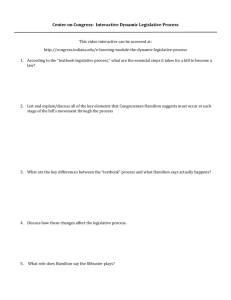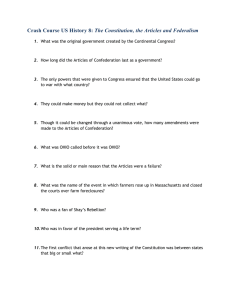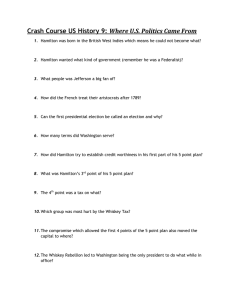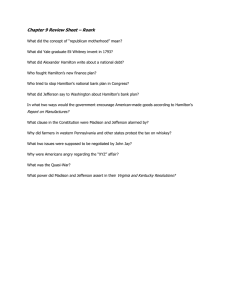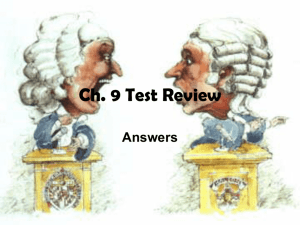Basic US History
advertisement
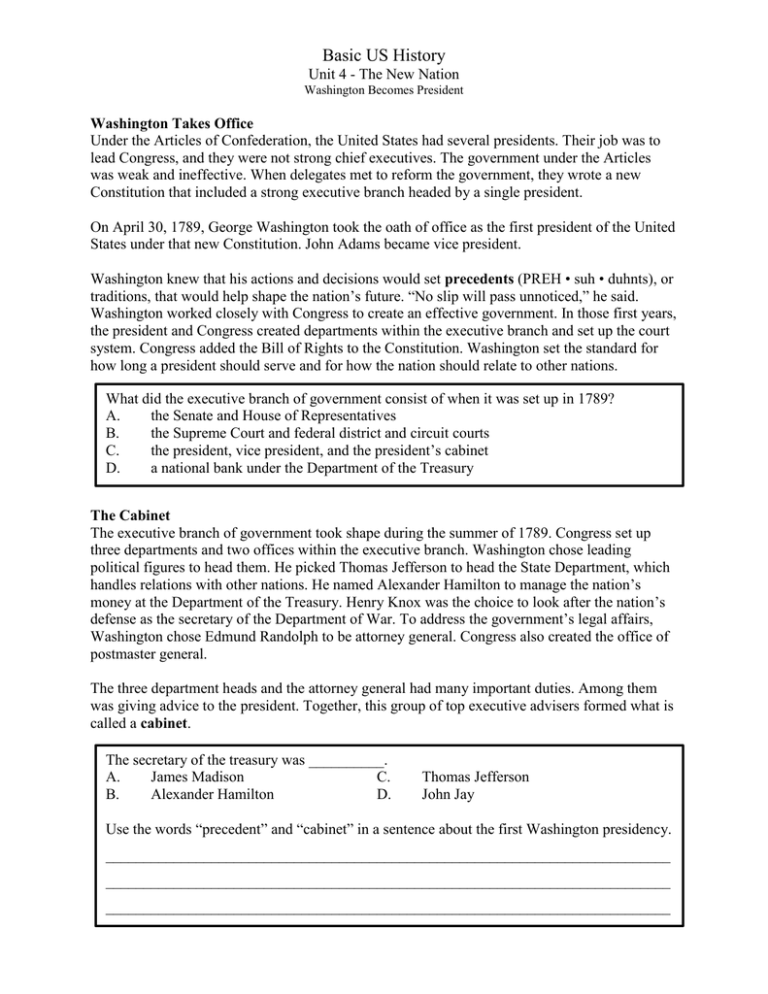
Basic US History Unit 4 - The New Nation Washington Becomes President Washington Takes Office Under the Articles of Confederation, the United States had several presidents. Their job was to lead Congress, and they were not strong chief executives. The government under the Articles was weak and ineffective. When delegates met to reform the government, they wrote a new Constitution that included a strong executive branch headed by a single president. On April 30, 1789, George Washington took the oath of office as the first president of the United States under that new Constitution. John Adams became vice president. Washington knew that his actions and decisions would set precedents (PREH • suh • duhnts), or traditions, that would help shape the nation’s future. “No slip will pass unnoticed,” he said. Washington worked closely with Congress to create an effective government. In those first years, the president and Congress created departments within the executive branch and set up the court system. Congress added the Bill of Rights to the Constitution. Washington set the standard for how long a president should serve and for how the nation should relate to other nations. What did the executive branch of government consist of when it was set up in 1789? A. the Senate and House of Representatives B. the Supreme Court and federal district and circuit courts C. the president, vice president, and the president’s cabinet D. a national bank under the Department of the Treasury The Cabinet The executive branch of government took shape during the summer of 1789. Congress set up three departments and two offices within the executive branch. Washington chose leading political figures to head them. He picked Thomas Jefferson to head the State Department, which handles relations with other nations. He named Alexander Hamilton to manage the nation’s money at the Department of the Treasury. Henry Knox was the choice to look after the nation’s defense as the secretary of the Department of War. To address the government’s legal affairs, Washington chose Edmund Randolph to be attorney general. Congress also created the office of postmaster general. The three department heads and the attorney general had many important duties. Among them was giving advice to the president. Together, this group of top executive advisers formed what is called a cabinet. The secretary of the treasury was __________. A. James Madison C. B. Alexander Hamilton D. Thomas Jefferson John Jay Use the words “precedent” and “cabinet” in a sentence about the first Washington presidency. ___________________________________________________________________________ ___________________________________________________________________________ ___________________________________________________________________________ Congress was unsure how much power the president ought to have over the cabinet. In a vote on this question, senators were evenly divided. Vice President John Adams broke the tie. He voted to allow the president the power to dismiss cabinet officers without Senate approval. This established presidential power over the whole executive branch. Which power given to the president by Congress established the president’s authority over the executive branch? A. the ability to appoint cabinet members B. the ability to appoint the executive branch members C. the ability to dismiss senators and representatives D. the ability to dismiss cabinet officers without Senate approval Establishing the Court System The first Congress also faced the job of forming the nation’s court system. Some favored a uniform legal system for the entire nation. Others favored keeping the existing state systems. The two sides reached an agreement in the Judiciary Act of 1789. This act established a federal court system. The states kept their own laws and courts, but the federal courts had the power to reverse state decisions. The act marked a first step in creating a strong and independent national judicial system. The Constitution established the Supreme Court as the final authority on many issues. President Washington chose John Jay to lead the Supreme Court as chief justice. The Senate approved Jay’s nomination. True OR False Disagreements arose between those favoring a uniform national legal system and those favoring state courts. The New Economy As president, Washington focused on foreign affairs and military matters. He rarely suggested new laws and almost always approved the bills that Congress passed. For the government’s economic policies, the president depended on Alexander Hamilton, secretary of the treasury. Hamilton was only in his early thirties when he took office, but he had bold plans and clear policies in mind. Hamilton faced a difficult task. The federal and state governments had borrowed money to pay for the American Revolution. They now owed millions of dollars to other countries and to American citizens. As a result, the nation faced serious financial trouble. Hamilton tried to improve the government’s finances and strengthen the nation at the same time. Hamilton’s Plan The House of Representatives asked Hamilton to make a plan for the “adequate support of the public credit.” This meant that the United States needed a way to borrow money for its government and economy. To be able to borrow in the future, the government had to prove it could pay back the money it already owed. Hamilton proposed that the federal government take over and pay off the states’ wartime debts. He argued that paying off the debt as a nation would build national credit and make it easier for the nation to borrow money. Hamilton also believed that federal payment of state debts would give the states a strong interest in the success of the national government. The Plan Faces Opposition Congress agreed to part of Hamilton’s plan - to pay the money owed to other nations. However, Hamilton’s plan to pay off the debt owed to American citizens caused protest. When borrowing money from citizens during the American Revolution, the government issued bonds. These are notes that promise repayment of borrowed money in the future. While waiting for repayment, many bond owners - shopkeepers, farmers, and soldiers - sold their bonds. They accepted less money than the bonds’ stated value. Often, the buyers of these bonds were speculators, people who risk money in hopes of making a large profit in the future. Now, Hamilton was proposing to pay off the old bonds at full value. This would make the speculators rich. The original bondholders would get nothing. Many people were upset by this idea. One newspaper said Hamilton’s plan was “established at the expense of national justice, gratitude, and humanity.” Even stronger opposition came from the Southern states. These states had accumulated, or built up, much less debt than the Northern states. Several had already repaid their debts. Yet Hamilton wanted the entire nation to pay all the debt together. Southern states complained about having to help pay other states’ debts. What is a bond? _____________________________________________________________ ___________________________________________________________________________ Why was the selling of bonds so controversial? ___________________________________________________________________________ ___________________________________________________________________________ ___________________________________________________________________________ Compromise and a Capital To win support for his plan, Hamilton worked out a compromise with Southern leaders. If they voted for his plan to pay off the state debts, he would support locating the nation’s capital in the South. Congress ordered a special district to be laid out between Virginia and Maryland along the banks of the Potomac River. There, George Washington chose the site for the new capital city, later named Washington, D.C., in his honor. While workers prepared the new city, the nation’s capital shifted from New York to Philadelphia. The new United States needed a way to borrow money for its government, its industrial development, and its commercial activity. What was one result of the compromise on Hamilton’s plan to pay off bonds issued during the American Revolution? A. removal of trade barriers B. the nation’s capital was located in the South C. protests by the Federalists D. reduced taxes in the North The Fight for a National Bank Hamilton also asked Congress to create a national bank - the Bank of the United States. The proposed bank would hold government funds and make debt payments. It would also issue a single form of money for use throughout the nation. At that time, different states and banks issued their own currencies. Having a national currency would make trade and all other financial actions much easier. Madison and Jefferson opposed a national bank, believing it would help the wealthy. They argued that the Constitution did not give Congress the power to create a bank. Hamilton believed the Constitution indirectly gave Congress power to create a bank when it gave Congress power to collect taxes and borrow money. Washington agreed, and Congress created the national bank. True OR False Madison and Jefferson supported the establishment of the Bank of the United States. Tariffs and Taxes Hamilton believed that the United States needed more manufacturing. He proposed high tariffs taxes on imports. The tariffs would raise money for the government and protect American industries from foreign competition. The South had little industry and opposed such tariffs. Congress passed only low tariffs. Hamilton also called for national taxes to help the government pay the national debt. Congress approved several taxes, including a tax on whiskey made in the United States. Hamilton’s ideas created conflict. Jefferson and Madison worried that Hamilton was building a dangerously powerful government run by the wealthy. They began to organize opposition to Hamilton and the policies he favored. The Whiskey Rebellion The new government wanted to collect taxes on some products made in the United States. In 1791 Congress passed a tax on the manufacture and sale of whiskey, a type of alcohol made from grain. Western Pennsylvania farmers were especially upset by this tax. Their anger turned into violence in July 1794. An armed mob attacked tax collectors and burned down buildings. This protest, called the Whiskey Rebellion, alarmed government leaders. They viewed it as a challenge to the power of the new government. Washington sent federal troops to meet the challenge. His action sent a strong message to the public: The government would use force to maintain order. What caused the Whiskey Rebellion? A. The government prevented the sale of whiskey. B. Pennsylvania farmers were upset about a tax on whiskey. C. The government used force to seize a whiskey business. D. American settlers brought whiskey into Ohio. Challenges in the West Washington worried about ongoing European interest in the Northwest Territory. The British and Spanish were trying to stir up Native American anger against American settlers in the region. To block these efforts, Washington signed treaties with Native American groups. Yet American settlers ignored the treaties and moved onto lands promised to Native Americans. Fighting broke out between the two groups. True OR False George Washington signed treaties with the Native Americans, hoping to lessen the influence of the British and Spanish on them. Again, Washington decided to use force. He sent an army under General Arthur St. Clair to restore order in the Northwest Territory. In November 1791, St. Clair’s army met a strong Native American force led by Little Turtle, a Miami chief. More than 600 U.S. soldiers died in the battle. It was the worst defeat U.S. forces had ever suffered against Native Americans. Americans hoped an alliance with France would help them achieve full control in the West. The possibility of French involvement led Great Britain to take action. In 1794 the British urged Native Americans to destroy American settlements west of the Appalachians. The British also began building a new fort in Ohio. What is Little Turtle, chief of the Miami people, famous for? A. working with the French against the Americans B. destroying American settlements west of the Appalachians C. helping the British build a fort in Ohio D. defeating United States troops led by General St. Clair Native Americans demanded that settlers who were living north of the Ohio River leave the area. In response, Washington sent Anthony Wayne, a Revolutionary War general, to the region. In August 1794, Wayne’s army defeated more than 1,000 Native Americans under Shawnee chief Blue Jacket. The Battle of Fallen Timbers, near present-day Toledo, Ohio, crushed the Native Americans’ hopes of keeping their land. In the Treaty of Greenville (1795), Native American leaders agreed to surrender most of the land in what is now Ohio. What did Native Americans agree to do in the Treaty of Greenville? ___________________________________________________________________________ Why do you think they agreed to do this? _________________________________________ ___________________________________________________________________________ ___________________________________________________________________________ ___________________________________________________________________________

